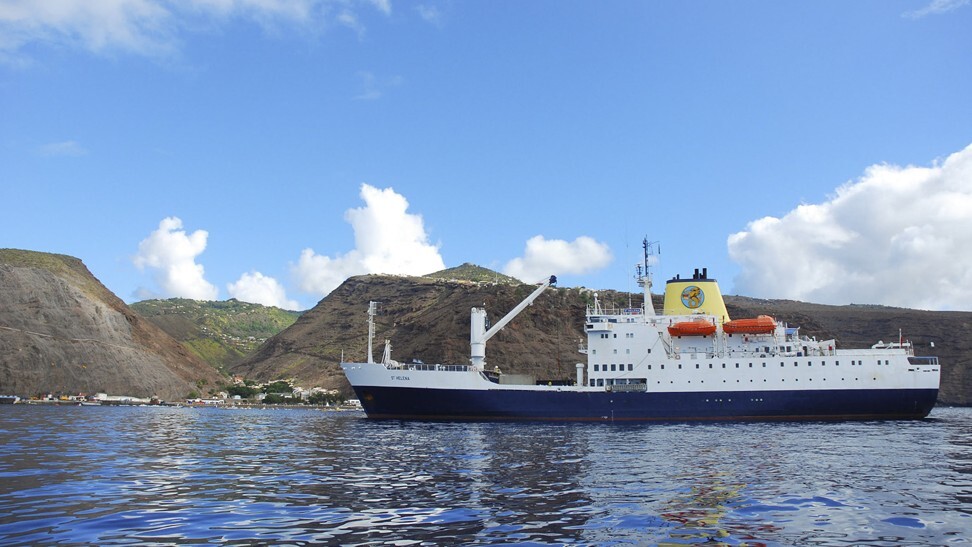
Website reveals extent of pain in the cruising industry, all at sea because of the coronavirus pandemic
- Hundreds of ships around the world are floating offshore, in quarantine or otherwise indisposed
- Plus, the population of St Helena becomes more isolated than ever after its only air link is suspended
No part of the travel industry has been hit more dramatically in recent months than luxury cruising, with hundreds of ships around the world floating just offshore in quarantine or otherwise indisposed, still filled with crews and, in some cases, passengers. Genting Hong Kong’s World Dream, which was under quarantine at the Kai Tak Cruise Terminal in February, is now laid up in Rotterdam, in the Netherlands, her schedule as Hong Kong’s most frequent floating visitor for 2020 looking doubtful.
Meanwhile, the gaudily decorated, Venetian-themed Costa Venezia – giving Chinese passengers a questionable taste of la dolce vita and operating out of Shanghai since last year – has been skulking off the south China coast since last month, unlikely to be of much appeal to other markets in her current form.
St Helena’s airport closes, leaving the tiny island isolated once again

I had the good fortune to spend several months on the small South Atlantic island of St Helena, from late 1997 to early 1998. Soon after returning to Hong Kong, I wrote an article about the British Overseas Territory for Post Magazine, describing its remoteness, the five-day Royal Mail Ship voyage from South Africa and life on shore: “After languorous days of deck quoits, Scrabble and clay-pigeon shooting, the island appears, dutifully dot-like, on the horizon. Within a few anxious hours the RMS St Helena pulled into James Bay with all the pomp and circumstance of a returning, victorious fleet.
“From first light, locals line the seafront in anticipation of long-lost friends, families and the latest videos, while passengers – some of whom may have been away for decades – grasp the railings as they strain for a glimpse of a familiar face. From the wireless room the radio operator plays Elgar over the Tannoy system as the Jamestown barges unload untold gallons of South African lager, UHT milk and containers from Tesco.”

In those days, the idea of an airport for St Helena, which is about twice the size of Hong Kong Island, was the subject of frequent debate. Locals, or “Saints”, seemed mostly in favour, while solitude-seeking immigrants (often slightly eccentric and mostly British) were usually against. In the end, the Saints got their way, although there was considerable sadness all round when the RMS said her last goodbye, on February 10, 2018.
Under construction since 2011, the St Helena Airport had been operational since 2017, after long delays due to unforeseen wind shear. A single airline, South African regional carrier Airlink, has operated a weekly flight from Johannesburg since then, but last month it halted all services “in support of South Africa’s lock-down to slow and contain the spread” of Covid-19.
Flights may resume on April 20, but until then – and one sadly suspects for rather longer – St Helena and its population (now just over 4,600) will be more isolated than ever.
On the upside, the island appears virus-free. A recent documentary called The World’s Most Useful Airport – looking at the Saints’ long struggle for an air link with the outside world – puts the concept of isolation into sobering and timely perspective, and can be found on YouTube.
Airlines retire Boeing 747s ahead of schedule

Retirement celebrations for the Boeing 747 are understandably low on airline to-do lists these days, and while the likes of Cathay Pacific, United Airlines and Singapore Airlines ended their long association with the aircraft in a flurry of publicity and commemorative flights, others are now doing so quietly.
Qantas, which launched 747 flights and the famously kitsch on-board Captain Cook Lounge back in 1971, and KLM, which also started 747 flights the same year, both appeared to permanently take their remaining 747 passenger aircraft (five and seven, respectively) out of service at the end of last month. Qantas originally planned to remove the last of its 747 fleet from service later this year, and KLM was to follow in 2021.
British Airways is scheduled to retire the last of its Boeing 747s in 2024, but there is understandable speculation that this year may also be the last for the carrier’s remaining fleet of more than 30.

